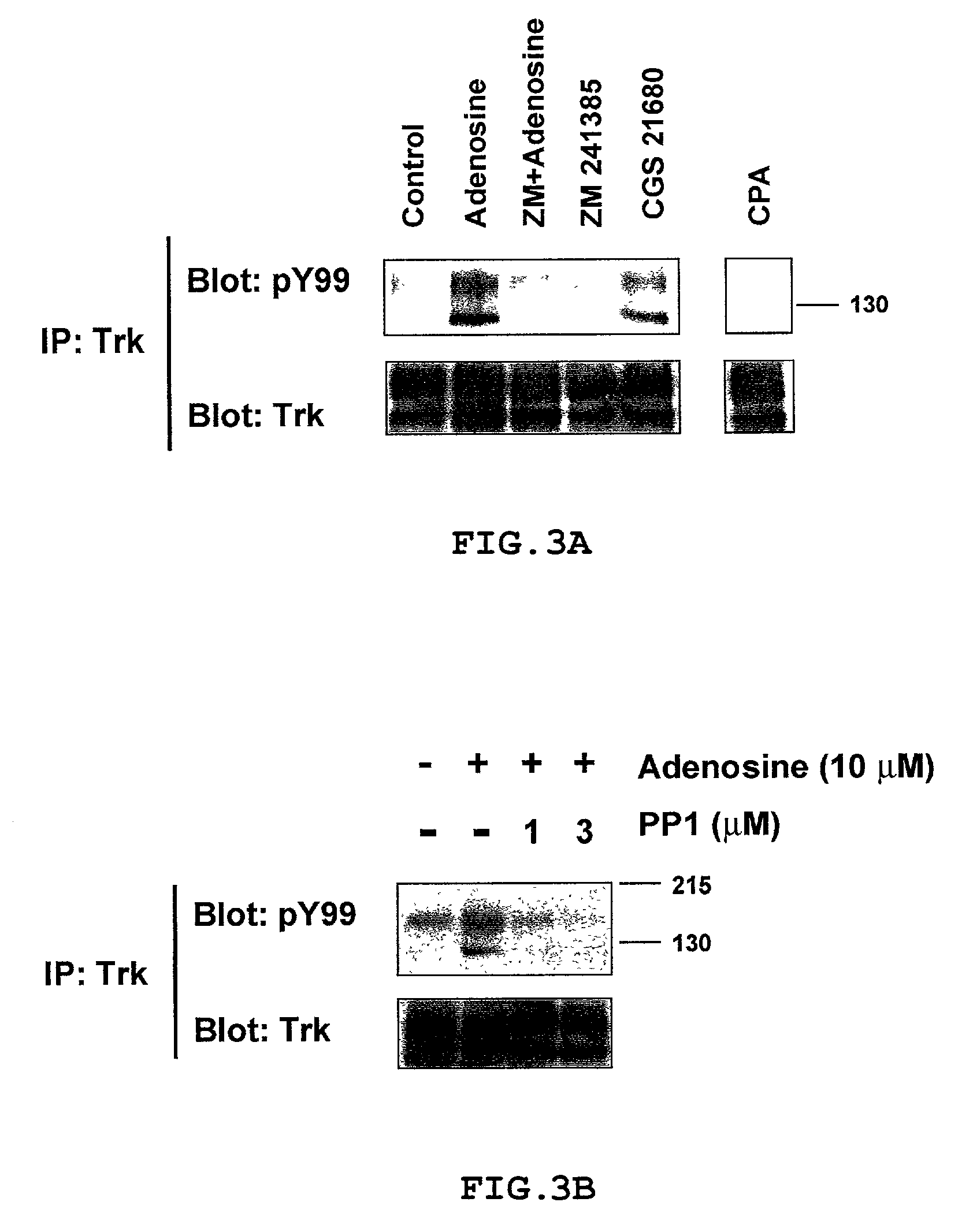Method for screening molecules that exert a neurotrophic effect through activation of neurotrophin receptors
a neurotrophin receptor and activation technology, applied in the field of activation of neurotrophin receptors, can solve the problems of gauging the optimal dosage of neurotrophic, unable to achieve the effect of subcutaneous administration of cntf and bdnf in als patients, and ineffective therapeutic procedures for delivering these proteins to patients
- Summary
- Abstract
- Description
- Claims
- Application Information
AI Technical Summary
Problems solved by technology
Method used
Image
Examples
example 1
[0052]This example describes an approach to use small molecule agonists to transactivate Trk neurotrophin receptors. Activation of Trk neurotrophin receptors was observed in PC12 cells and hippocampal neurons after treatment with adenosine, a neuromodulator that acts through G protein-coupled receptors. Theses effects were reproduced by using the adenosine agonist CGS21680 and were counteracted with the antagonist ZM241385, indicating that this transactivation event by adenosine involves adenosine 2A receptors. The increase in Trk activity could be inhibited by the use of the Src family specific inhibitor, PP1, or K252a, an inhibitor of Trk receptors. In contrast to other G protein-coupled receptor transactivation events, adenosine utilized Trk receptor signaling with a longer time course. Moreover, adenosine activated PI3-K / Akt through a Trk-dependent mechanism that functionally resulted in increased cell survival after NGF or BDNF withdrawal. Therefore, adenosine acting through th...
example 2
Materials and Methods
[0081]Immunoprecipitated and Immunoblotting. PC12 (615) cells were maintained in DMEM containing 10% FBS supplemented with 100 units / ml penicillin, 100 μg / ml streptomycin, and 2 mM glutamine plus 200 μg / ml G418. Cells were placed in serum free medium overnight before experiments. Cell lysates from PC12(615) cells, or basal forebrain cells were incubated in lysis buffer (1% Nonidet P-40) for 4 hrs to overnight at 4° C. with anti-pan-Trk polyclonal antibody followed by incubation with protein A-Sepharose beads. Equivalent amounts of protein were analyzed for each condition. The beads were washed five times with lysis buffer, and the immune complexes were boiled in SDS-sample buffer and loaded on SDS-PAGE gels for immunoblot analysis. The immunoreactive protein bands were detected by enhanced chemiluminescence (Amersham Pharmacia).
[0082]Basal Forebrain Cell Cultures. Dissociated primary cultures of basal forebrain neurons from embryonic day 18 (E18) rats were prepa...
PUM
| Property | Measurement | Unit |
|---|---|---|
| concentrations | aaaaa | aaaaa |
| concentrations | aaaaa | aaaaa |
| time periods | aaaaa | aaaaa |
Abstract
Description
Claims
Application Information
 Login to View More
Login to View More - R&D
- Intellectual Property
- Life Sciences
- Materials
- Tech Scout
- Unparalleled Data Quality
- Higher Quality Content
- 60% Fewer Hallucinations
Browse by: Latest US Patents, China's latest patents, Technical Efficacy Thesaurus, Application Domain, Technology Topic, Popular Technical Reports.
© 2025 PatSnap. All rights reserved.Legal|Privacy policy|Modern Slavery Act Transparency Statement|Sitemap|About US| Contact US: help@patsnap.com



